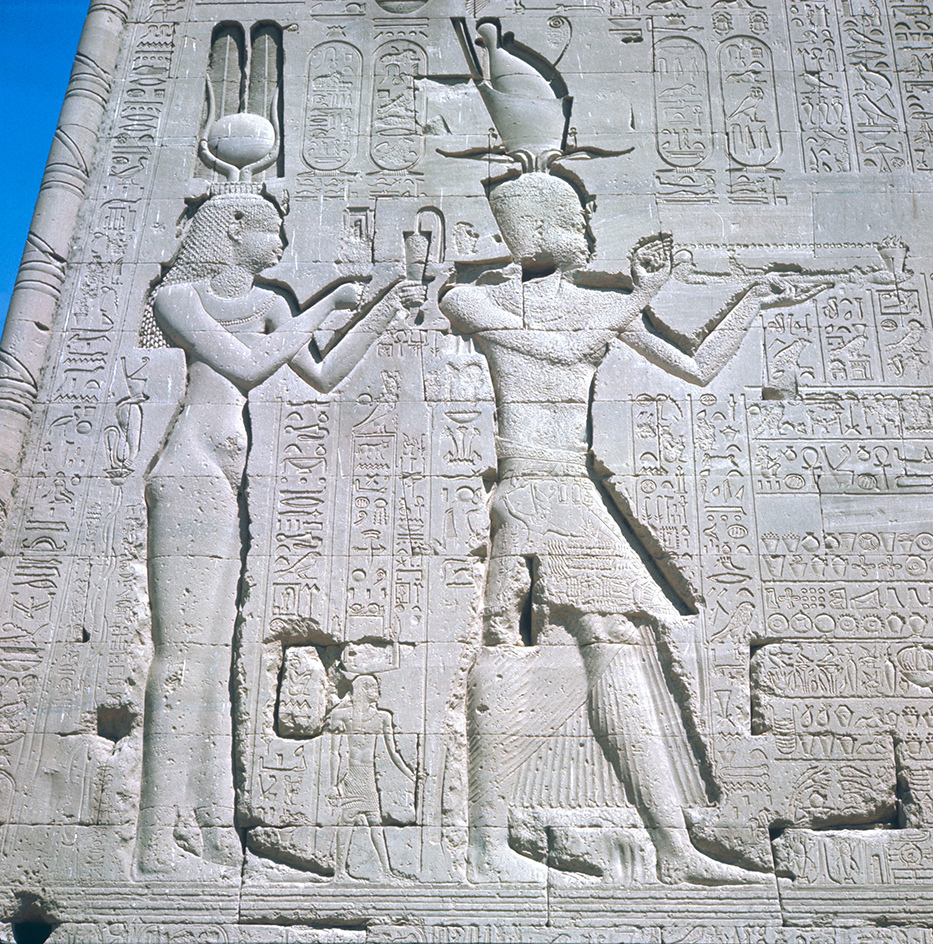Cleopatra, << klee uh PAT ruh >> (69-30 B.C.), was a queen of ancient Egypt and one of the most fascinating women in history. Through the years, she gained a reputation for beauty, but scholars disagree about her appearance. They agree, however, that she was intelligent, charming, witty, and ambitious. At times, Cleopatra was ruthless. However, she took a great interest in her subjects’ welfare and won their affection. She developed romantic relationships with Julius Caesar and Mark Antony, two of the greatest Roman leaders of her day.

Cleopatra belonged to the dynasty (series of rulers in the same family) founded by Ptolemy I in 323 B.C. Ptolemy was a general in the army of the Macedonian conqueror Alexander the Great. Cleopatra is also known as Cleopatra VII because she was the seventh Egyptian queen of Macedonian descent with that name.
Cleopatra and Caesar.
In 52 B.C., Cleopatra became co-ruler with her father, Ptolemy XII. Following his death in 51 B.C., Cleopatra and her 10-year-old brother, Ptolemy XIII, became co-rulers and married. Earlier rulers in the Ptolemaic dynasty had adopted the practice of marriage between brothers and sisters.
In 49 B.C., young Ptolemy’s guardians seized power for him and drove Cleopatra from the throne. The next year, Julius Caesar arrived in Alexandria, Egypt’s capital. He came in pursuit of Pompey, a Roman general and rival in Caesar’s struggle to become the ruler of Rome. Caesar and Cleopatra met and became lovers.
Caesar defeated Cleopatra’s opponents. Ptolemy XIII drowned while trying to escape. Caesar then put Cleopatra back on the throne along with another brother, Ptolemy XIV. In 47 B.C., Cleopatra gave birth to a boy, Ptolemy Caesar, also known as Caesarion and recognized in Egypt as Caesar’s son. In 46 B.C., at Caesar’s invitation, Cleopatra went with Caesarion and Ptolemy XIV to Rome. She stayed there until 44 B.C., when a group of Roman aristocrats assassinated Caesar. After returning to Egypt, Cleopatra had her brother Ptolemy killed so that Caesarion could reign with her as Ptolemy XV.
Cleopatra and Mark Antony.
In 41 B.C., Mark Antony invited Cleopatra to Tarsus in Asia Minor (now part of Turkey). Antony was then one of the rulers of Rome, with Gaius Octavian (later called Augustus) and Marcus Aemilius Lepidus. Antony had met Cleopatra when she stayed in Rome as Caesar’s guest. Antony wanted to rule Rome alone and hoped to obtain financial aid from Cleopatra. Antony and Cleopatra became lovers. In 40 B.C., Cleopatra gave birth to twins, Alexander Helios and Cleopatra Selene. For political reasons, Antony left Cleopatra and married Octavia, the sister of his co-ruler Octavian (see Octavia ). In 37 B.C., Antony abandoned Octavia and resumed his relationship with Cleopatra. In 36 B.C., she had another son by him, Ptolemy Philadelphos.
Antony and Cleopatra worked together to achieve their ambitions. He believed that the wealth of Egypt would help him become the sole ruler of Rome. She wished to preserve Egypt from direct rule by Rome. In 34 B.C. Antony married Cleopatra. He appointed her and Caesarion rulers of Cyprus, Egypt, Libya, and areas along the Syrian coast. He gave his sons and daughter by Cleopatra much of the land once ruled by Alexander the Great. These actions angered Antony’s co-rulers and rivals. Octavian regarded Cleopatra as greedy and ambitious, and claimed that she had turned Antony into a helpless puppet.
In 32 B.C., Octavian went to war against Antony and Cleopatra. In 31 B.C., forces of Antony and Cleopatra lost the Battle of Actium off the west coast of Greece (see Actium, Battle of ). The couple then returned to Alexandria. A few months later, Octavian came after them. In 30 B.C., after Octavian reached Egypt, Cleopatra spread a report that she had committed suicide. Antony heard the report and stabbed himself out of grief. Before he died, Antony learned that Cleopatra was alive. His followers carried him to her, and he died in her arms.
Cleopatra believed that Octavian would publicly humiliate her in Rome. She tried to make peace with him but failed. In despair, Cleopatra took her life by placing an asp, a poisonous snake, on her chest or arm. The Romans murdered Caesarion because they feared he would claim to be Caesar’s heir and the rightful ruler of Rome’s empire. The deaths of Cleopatra and Caesarion ended the rule of the dynasty of the Ptolemies in Egypt.
Cleopatra’s reputation in history comes largely from the views of Octavian, who described Antony as the lovestruck victim of a wicked temptress. The Roman poets Virgil and Horace also adopted this version. Cleopatra’s story has been told many times in literature. It is dramatized in the famous plays Antony and Cleopatra (about 1607) by the English playwright William Shakespeare, All for Love (1677) by the English dramatist John Dryden, and Caesar and Cleopatra (1901) by the Irish-born playwright George Bernard Shaw.
See also Antony, Mark ; Augustus ; Caesar, Julius .
